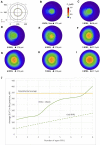Three-Dimensional Model of Sub-Plasmalemmal Ca2+ Microdomains Evoked by T Cell Receptor/CD3 Complex Stimulation
- PMID: 35281279
- PMCID: PMC8906516
- DOI: 10.3389/fmolb.2022.811145
Three-Dimensional Model of Sub-Plasmalemmal Ca2+ Microdomains Evoked by T Cell Receptor/CD3 Complex Stimulation
Abstract
Ca2+ signalling plays an essential role in T cell activation, which is a key step to start an adaptive immune response. During the transition from a quiescent to a fully activated state, Ca2+ microdomains of reduced spatial and temporal extents develop in the junctions between the plasma membrane and the endoplasmic reticulum (ER). These microdomains rely on Ca2+ entry from the extracellular medium, via the ORAI1/STIM1/STIM2 system that mediates store operated Ca2+ entry Store operated calcium entry. The mechanism leading to local store depletion and subsequent Ca2+ entry depends on the activation state of the cells. The initial, smaller microdomains are triggered by D-myo-inositol 1,4,5-trisphosphate (IP3) signalling in response to T cell adhesion. T cell receptor (TCR)/CD3 stimulation then initiates nicotinic acid adenine dinucleotide phosphate signalling, which activates ryanodine receptors (RYR). We have recently developed a mathematical model to elucidate the spatiotemporal Ca2+ dynamics of the microdomains triggered by IP3 signalling in response to T cell adhesion (Gil et al., 2021). This reaction-diffusion model describes the evolution of the cytosolic and endoplasmic reticulum Ca2+ concentrations in a three-dimensional ER-PM junction and was solved using COMSOL Multiphysics. Modelling predicted that adhesion-dependent microdomains result from the concerted activity of IP3 receptors and pre-formed ORAI1-STIM2 complexes. In the present study, we extend this model to include the role of RYRs rapidly after TCR/CD3 stimulation. The involvement of STIM1, which has a lower KD for Ca2+ than STIM2, is also considered. Detailed 3D spatio-temporal simulations show that these Ca2+ microdomains rely on the concerted opening of ∼7 RYRs that are simultaneously active in response to the increase in NAADP induced by T cell stimulation. Opening of these RYRs provoke a local depletion of ER Ca2+ that triggers Ca2+ flux through the ORAI1 channels. Simulations predict that RYRs are most probably located around the junction and that the increase in junctional Ca2+ concentration results from the combination between diffusion of Ca2+ released through the RYRs and Ca2+ entry through ORAI1 in the junction. The computational model moreover provides a tool allowing to investigate how Ca2+ microdomains occur, extend and interact in various states of T cell activation.
Keywords: COMSOL; ER-PM junctions; NAADP; T cells; ca2+ signalling; computational model; ryanodine receptors; store operated calcium entry.
Copyright © 2022 Gil, Diercks, Guse and Dupont.
Conflict of interest statement
The authors declare that the research was conducted in the absence of any commercial or financial relationships that could be construed as a potential conflict of interest.
Figures











Similar articles
-
Three-Dimensional Model of Sub-Plasmalemmal Ca2+ Microdomains Evoked by the Interplay Between ORAI1 and InsP3 Receptors.Front Immunol. 2021 Apr 28;12:659790. doi: 10.3389/fimmu.2021.659790. eCollection 2021. Front Immunol. 2021. PMID: 33995380 Free PMC article.
-
Ca2+ puffs underlie adhesion-triggered Ca2+ microdomains in T cells.Biochim Biophys Acta Mol Cell Res. 2024 Dec;1871(8):119808. doi: 10.1016/j.bbamcr.2024.119808. Epub 2024 Aug 14. Biochim Biophys Acta Mol Cell Res. 2024. PMID: 39151474 Review.
-
ORAI1, STIM1/2, and RYR1 shape subsecond Ca2+ microdomains upon T cell activation.Sci Signal. 2018 Dec 18;11(561):eaat0358. doi: 10.1126/scisignal.aat0358. Sci Signal. 2018. PMID: 30563862 Free PMC article.
-
Interplay between ER Ca2+ Binding Proteins, STIM1 and STIM2, Is Required for Store-Operated Ca2+ Entry.Int J Mol Sci. 2018 May 19;19(5):1522. doi: 10.3390/ijms19051522. Int J Mol Sci. 2018. PMID: 29783744 Free PMC article.
-
T cell Ca2+ microdomains through the lens of computational modeling.Front Immunol. 2023 Oct 4;14:1235737. doi: 10.3389/fimmu.2023.1235737. eCollection 2023. Front Immunol. 2023. PMID: 37860008 Free PMC article. Review.
Cited by
-
Computational insights in cell physiology.Front Syst Biol. 2024 Mar 13;4:1335885. doi: 10.3389/fsysb.2024.1335885. eCollection 2024. Front Syst Biol. 2024. PMID: 40809125 Free PMC article. Review.
-
The Modulatory Effects of Statins, Vitamin E, and Moringa Oleifera Extract on CD3 Expression in Ribociclib-Induced Hepatotoxicity in Rats.Acta Inform Med. 2025;33(2):90-95. doi: 10.5455/aim.2025.33.90-95. Acta Inform Med. 2025. PMID: 40606240 Free PMC article.
-
New insights into the stromal interaction molecule 2 function and its impact on the immunomodulation of tumor microenvironment.Cell Biosci. 2024 Sep 13;14(1):119. doi: 10.1186/s13578-024-01292-8. Cell Biosci. 2024. PMID: 39272139 Free PMC article. Review.
-
Emerging optogenetics technologies in biomedical applications.Smart Med. 2023 Nov 1;2(4):e20230026. doi: 10.1002/SMMD.20230026. eCollection 2023 Nov. Smart Med. 2023. PMID: 39188295 Free PMC article. Review.
-
NAADP Signaling: New Kids on the Block.Cells. 2022 Mar 21;11(6):1054. doi: 10.3390/cells11061054. Cells. 2022. PMID: 35326505 Free PMC article.
References
-
- Ahmad M., Ong H. L., Saadi H., Son G. Y., Shokatian Z., Terry L. E., et al. (2021). Functional Communication between IP3R and STIM2 at Sub-threshold Stimuli Is a Critical Checkpoint for Initiation of SOCE. Proc. Natl. Acad. Sci. U S A 119 (3), e2114928118. 10.1073/pnas.2114928118 - DOI - PMC - PubMed
LinkOut - more resources
Full Text Sources
Miscellaneous

